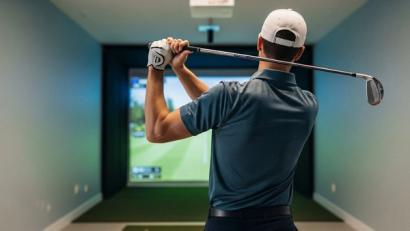

In the high-flying corporate world, it used to be that pushing yourself to the extreme was the badge of honour one would carry on the wild ride to the corner office – and once that bit of real-estate was in the back pocket, it was accepted that the toll on your mind and body would then be even greater. Eating well and sleeping deeply were fare for the less-determined; sacrifice was the real currency of the workplace. These days, however, we’re more than aware that burnout can lead to a blow-up, and the results are not favourable. ‘If you’re out of the picture, who’s left steering the ship? Suddenly, it’s game over,’ says Dr. Jonathan Clark-McKellar, the managing director of Andarta, a premier, soon- to-open London clinic that, through precision medicine, specialises in maximising longevity and optimising performance for its (often impressive) clients.
So, with a chaotic year ahead, we’ve spoken to the experts about the fundamentals that CEOs (both current and budding) should consider in order to better moderate the brutal impact of their lifestyle. With Clark-McKellar, we discuss several areas, including training, nutrition and active recovery techniques; we draw upon the expertise of Dr. Rebecca Robbins, the sleep expert to Savoir Beds and an assistant professor and scientist at Brigham and Women’s Hospital (a teaching hospital of Harvard Medical School); and for tips on centring yourself, we have a few pointers from Rob Rea, a breathwork and performance coach.
01. TRAINING
Although CEOs can’t do away with the stress-inducing tasks that they must face, what they can do, says Clark-McKellar, ‘is build up the body’s ability to handle those stressors.’ The key problem here is how to fit all the necessary exercise in. ‘Learning proper techniques and strategies means we can streamline to the essentials.’
Cardio
‘Targeted, intelligent cardiovascular training can help high performers manage the physiological effects of stress, particularly elevated heart rate and blood pressure. Try the Scandinavian 4×4 interval approach, which, after a short warm-up, takes less than 40 minutes. This is essentially four rounds of intense four-minute intervals (e.g. running or cycling) at 90–95 per cent of maximum heart rate, with a four-minute recovery between each one. One study demonstrated that regular use of this type of training actually reversed signs of heart aging in sedentary 50-year-olds.’
Strength
‘Muscle acts as an organ, playing a big role in regulating glucose levels, hormones and even cognitive function. Building muscle also helps release brain-derived neurotrophic factor, which is linked to reduced depressive symptoms and sharper cognition’. For the time-poor, ‘cluster sets’ are recommended – these, in effect, are ‘short, strategic workouts that fit seamlessly into a busy day. Take a single heavy kettlebell into the office, for example. We might have our clients perform a set of three goblet squats, rest for 10 seconds, and repeat this for two minutes, totalling 36 heavy reps. We then have them repeat this process with kettlebell swings or similar movements the next hour.’
02. OSCILLATION
Despite what convention may say, managing stress isn’t so much about jettisoning your to-do list. The aim, instead, is ‘helping the body disconnect from stressors periodically,’ says Clark-McKellar. ‘Our brains are incredibly effective at generating stress responses, sometimes just from thinking about a tense conversation. That’s why we encourage rituals that allow one to mentally detach and recalibrate, a strategy known as “oscillation”.’
The cluster sets are a recommended ritual, as is one technique – ‘box breathing ’ – that Andarta borrows from its work with U.S. Navy SEALs. This helps to quickly reset the nervous system, and is executed by doing the following: ‘breathing in slowly and purposefully through the diaphragm for four seconds; holding that breath for four seconds; exhaling slowly, through pursed lips, for four seconds; and finally holding again with empty lungs and a relaxed body for another four seconds.’ By repeating this a few times, there’s a big impact on clarity of mind, a reduced heart rate and respiratory rate and a lowering of blood pressure.
03. ACTIVE RECOVERY TECHNIQUES
‘We find a range of active recovery techniques extremely effective for building cardiovascular, endocrine and cognitive resilience,’ says Clark-McKellar. For Andarta, thermal therapies – hot and cold conditions – are preferred. Traditional methods – such as dry saunas or plunge pools – are recommended over more tech-heavy options, such as cryo-chambers. ‘It’s not that we’re against technological solutions; if there’s solid evidence, we’re all for it,’ says Clark-McKellar. ‘But these traditional methods currently have more research backing’.
Hot therapy
Clark-McKellar points to a recent Scandinavian study that reported that frequent sauna use can reduce the likelihood of sudden cardiac death by between 22–67 per cent, depending on regularity. ‘We typically recommend two–four sessions per week, with each session lasting at least 15 minutes at over 80°C. (A single 20-minute session at the same temperature still provides good benefits.)’
Cold therapy
This does wonders for cognitive and mood enhancement, and, when combined with specific breathing techniques, can be incredibly effective, states Clark-McKellar. He points to another study, which was conducted in 2022, that showed that pairing cold-water exposure (down to 10°C for up to a minute) with pranayama (an ancient breath technique) can lead to a major lowering of ‘perceptions of stress.’
04. NUTRITION
Despite the internet fads, social-media trends and suspect literature, there is no one-size-fits-all diet. Goals, after all, vary widely, from muscle gain to burning fat.
When stressed or time-poor
‘For most clients, it’s about helping them make healthier choices’, says Clark-McKellar, ‘especially when they’re stressed or short on time. We often provide simple principles for guiding them through these situations. For instance, poor sleep – just one bad night – can raise blood sugar to pre-diabetic levels, so we might suggest high-protein, low-carb breakfast options (e.g. eggs with spinach, avocado and salmon), especially for mornings after long flights or disrupted nights.’
Protein
‘We generally recommend more protein than the standard RDA’, he continues, ‘about 1.1g per kg of lean body weight to maintain body composition. This becomes especially important during stress, as cortisol, the stress hormone, tends to break down muscle and store fat. So, for an average man, that’s around 88–94g per day. If we’re aiming to build muscle, we’d increase that to around 1.8g per kg (150–160g per day for men)’.
Supplements
‘Whole foods’, Clark-McKellar advises, ‘are always the best choice for satiety and micronutrient content’, but smart supplementation can be beneficial. ‘Those in the northern hemisphere could benefit from vitamin D due to a lack of sunlight, and magnesium is something we often increase during high-stress periods, as it’s depleted through both stress and sweating. For all our high performers, we recommend 5g of creatine per day, as it supports strength. We don’t see any benefit in oral NMN supplementation, and evidence for IV use is scant’.
05. SLEEP
Build a routine
Even though eight is often the magic number when it comes to the hours we need for a good night of sleep, Dr. Rebecca Robbins says you should emphasise the quality and consistency. Achieving healthy sleep is partly dictated by our internal circadian rhythm, the system that monitors when we should be alert and when we should be tired – and a consistent bedtime allows the rhythm to become well-tuned to our patterns. Constantly fluctuating wake and sleep times create disorientation. ‘When we alter our sleep schedules by more than one hour, we actually give our brain a signal that we are trying to shift to a new time zone, making our ability to get back to our sleep schedule the next night a challenge, triggering a potential downward spiral of sleep disruption,’ says Dr. Robbins.
This, therefore, means no more late nights and weekend lie-ins. Clark-McKellar corroborates this by saying that the one-hour change ‘can impact mood, cognition, and stress markers like HRV that day, and the number of heart attacks actually increase nationally when the clocks go forward and back.’
The optimal sleeping temperature
Dr. Robbins recommends a ‘thermal neutral’ zone that ranges from 18–20.5°C – this allows ‘for the optimal sleep, because exposure to swings in temperatures (too hot or too cold) could increase the likelihood that we experience sleep disruptions because we are unable to regulate our temperature in certain sleep stages.’
A bed made from natural, breathable materials, such as those from Savoir Beds, will wick away moisture and maintain a cool body temperature. Moreover, the right mattress should support the spine and also align the head, neck and back.
When waking up in the middle of the night
Trying to force yourself to drift off back to sleep might yield the opposite result. ‘When you find yourself up in the middle of your sleep, avoid looking at the clock, and try to tell yourself, “I got this, I’m up, no big deal,”’ advises Dr. Robbins. ‘Then, if something woke you up, like having to use the bathroom, go do whatever it is that woke you up, then get back to bed and try to fall asleep. If you cannot get back to sleep, get out of bed, keep the lights low, and do something relaxing, then go back to bed when you are tired.’ Folding laundry, a bit of yoga or reading tends to work for us.
Napping
Dr. Robbins also advises that instead of reaching for coffee in the day, try a short nap. Clark-McKellar also advocates short bursts of sleep. He recommends 17–20-minute naps, ideally six–eight hours before your main sleep, as they can ‘restore cognitive function for the sleep-deprived’. There’s a catch, however – ‘naps can actually clear adenosine, the brain chemical that makes you sleepy, which can lead to trouble falling asleep later. That’s why we recommend prophylactic napping: nap in anticipation of fatigue, not after it hits.’
06. BREATHWORK
Where should I start?
It all begins with awareness, argues Rob Rea. ‘Ask yourself, “How am I breathing? Through the mouth or nose? Is it fast or slow, soft or hard, quiet or noisy?” Breath: The New Science of a Lost Art by James Nestor is a great starting point and will get you nasal breathing.’
The optimal time
Like some answers here, it depends on the individual. ‘Any time allocated to breathwork or meditation is better than no time,’ says Rea. For your morning routine ‘you could integrate drinking a glass of water, moving your body, sitting in stillness and five minutes of conscious breathing.’
How long should we stick with it?
Impatience, both for the general public and the tense exec, is a common reason why many don’t stick to consistent breathwork. But such techniques, says Rea, ‘change physiology (and therefore psychology) instantly.’ We shouldn’t see it as goal-oriented – rather, it’s ‘to experience what is in the moment. The by-product of the practice is that when you encounter situations where you might need to centre yourself, the breathwork that you’ve practised becomes default.’
THINGS TO AVOID
1. ‘Alcohol in small quantities when consumed with a meal may not have a huge impact on sleep’, says Dr. Robbins, ‘but much more than a single dose can impair sleep, such as by increasing nighttime awakenings and sleep fragmentation.’
2. Another hindrance to sleep is stress. ‘Stress management techniques (e.g. breathing exercises and mindfulness [see more later]) over the course of the day can help us better manage stress’, as they can lead to a calmer mind and relaxed body.
3. ‘Many devices that emit blue light can limit our ability to fall asleep and benefit from deep, restorative sleep,’ reports Dr. Robbins. Instead, do what relaxes you before bed, whether that’s reading, taking a hot shower, or, again, breathwork – by committing to this routine, you’re allowing your brain to know that what comes next is sleep.
4. For those with deadlines, Clark-McKellar says that: ‘If you must work, print research and emails off and make notes by hand.’
MANAGING JET LAG
This is particularly important for both the literal and figurative high-flyers. ‘Our bodies take about a day to adjust to each hour of time difference,’ says Clark-McKellar. ‘So, moving west from London to New York – five hours behind – requires around five days to fully acclimate.
1. Pre-flight – ‘Shifting your sleep gradually (to align with your new time zone) in preparation for a business trip – 20–30 minutes earlier per night if going west – can make a big difference.’
2. On the flight – ‘Set your watch to the destination time zone and follow it with regards to meals and sleep. Aim to sleep in the first half of a long flight; melatonin, used wisely, can help with this, and avoid caffeine and alcohol before and during the flight. Set an alarm and wake 12 hours before your intended bedtime in your new time zone. Avoid naps unless absolutely necessary’.
3. Touchdown – ‘Schedule critical meetings or events at times that align with your previous time zone to the greatest extent possible. For westward travel, aim for earlier meetings; for eastward, opt for later in the day.’
Take your wellness journey to the next level at one of these science-led wellness hotels...


